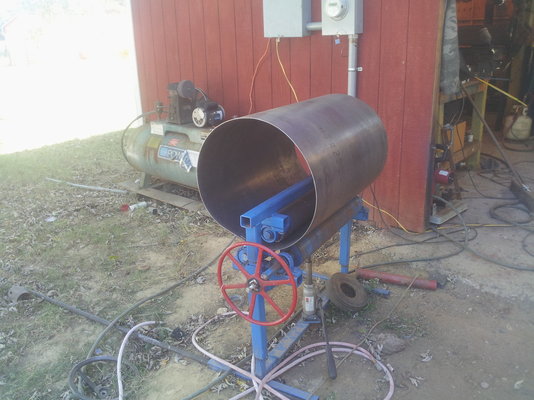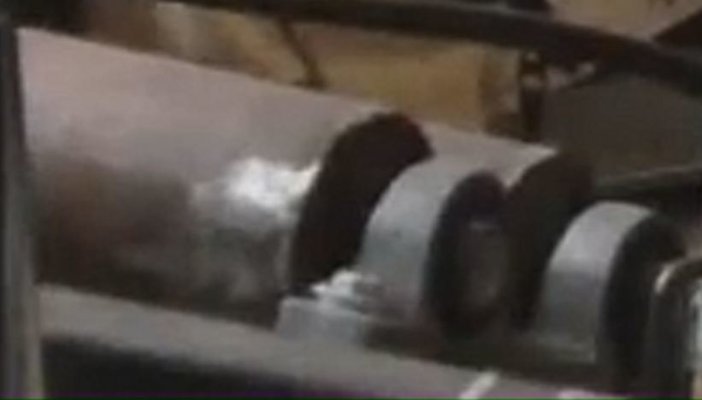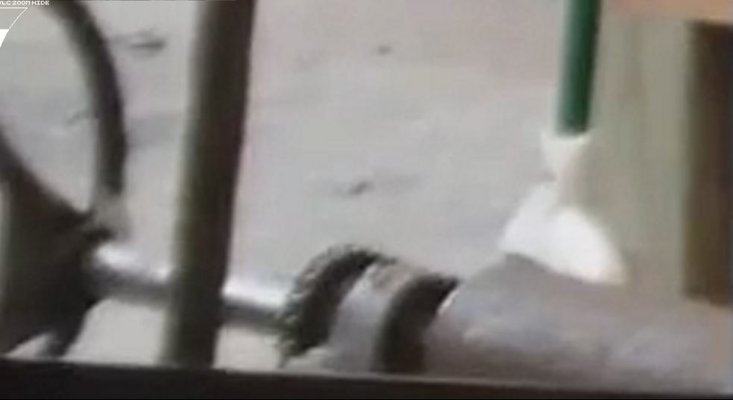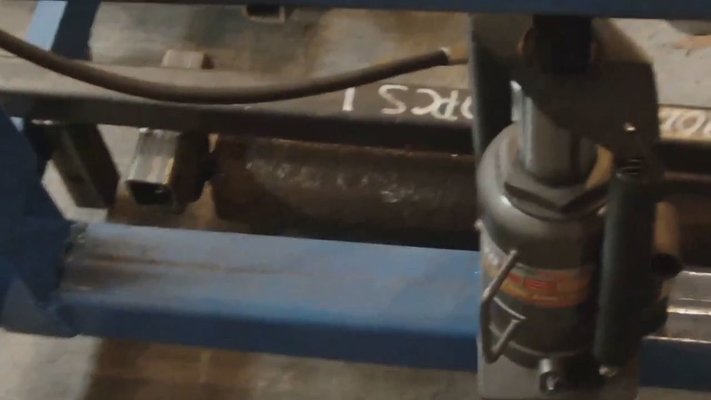I have a set of imported 12" slip rolls from RGD/Chronos or whoever. They work well but are a bit limited with regard to the material width that they can handle. I had a look for some wider ones on Ebay but the prices get a bit silly quite quickly. Now I'm not saying the prices aren't justified but some look a bit flimsy. I thought I would have a go at creating an underbuilt set of my own. My reasoning is to get another tool to use but also to get bit of time on the the tools that I already own to learn a bit about them as I make it. If I end up with a useless ornament it will not be time wasted.
I used the Dave Gingery plans as my basis. He wrote a number of books on how to build machine tools at home. The now departed bloke was from the states so everything in his designs were imperial. He uses inch and a half pipe for the rolls. Pipe is usually measured by ID rather than OD but I didn't look too closely at his measurements as I didn't have his materials to hand anyway. I do have some 33.7mm by 3mm wall CHS kicking about though. I would rather have some 38mm by 6mm CDS tube but the prices are prohibitive for a bit of an experiment. If this one goes well I may remake it. I am only looking to roll 0.8mm or 1mm mild steel so I hope the tubes will be strong enough. They aren't particularly round to be honest either which I think might be a greater hinderance to the tool working well. Anyway some photos.
This is the basic design I am working off. This is just the side plate. I am using smaller diameter tubes so I had to make my own dimensions up and make sure they worked. I decided to make a template out of 3mm steel to ensure that everything worked out ok without having to cut drill and mill the expensive and time consuming thick plate. I also had my manufactured set of rolls to take design cues from. Essentially, when the rolls are at their closest they are touching. The top and bottom rolls just pinch the material so they only need a couple of mill clearance at the extreme for my purposes, the roller on the angle on the back needs a bit more adjustability as it gives a tighter roll the closer it gets.
My tubes were effectively 34mm diameter due to being so roughly made so my first two holes are 34mm apart. I have two squares of 3mm plate tacked together at the corners so I get mirror copies with one set of drilling.


The top tube is removable hence the cut to the edge. This allows the rolled material to be removed off the rolls once finished.

The tubes with bushings. these two tubes grip and pull the material through. the tube behind bends the material and sets the curve.


I made six of these bungs in the lathe. The narrow end is 12mm, the bronze oleite bush is 16mm OD. The OD on the thick end is about 28.2mm. Roughly a push fit into the tube. I tried to dress the welds down on the inside of the tube so some are a bit slacker than others. They will get welded together so the fitment isn't critical. the middle lip is the same OD as the tube. I turned these down from 35mm en1a on my Southbend lathe which gave me plenty of practice turning. The biggest cut I can take is about 25 thou so 1.25mm per cut max over the diameter which a lot of cuts down from 35mm to 12mm especially when experimenting with speeds and feeds, HSS and different carbide inserts etc. I quite enjoyed grinding HSS tools for this. It doesn't work any worse than carbide on my little lathe. I never managed to get a decent finish regardless of what I did. I know that en1a is not really suitable for welding but it's not like it is going on a car or anything so I think it should be ok.
I made the last three bungs a lot longer as I will need to cut keyways etc and it is always better to have too much material to play with than too little.
Two 12mm plates welded together this time. I bought these and then had second thoughts that they might be too thin. You can see two 20mm plates wrapped in cling film in the background. I thought I would start with the 12mm as I didn't really fancy cutting and shaping 40mm thick steel. 24mm is bad enough.

Portamig 235. Seems a decent weld to me.

Basic template laid out. I know the dimensions I need and there are no centres left to pick out of the practice piece so it is neither use nor ornament really.

Two points 34mm apart. Scribe lines use to get the third mark with a pair of dividers.

I used the Dave Gingery plans as my basis. He wrote a number of books on how to build machine tools at home. The now departed bloke was from the states so everything in his designs were imperial. He uses inch and a half pipe for the rolls. Pipe is usually measured by ID rather than OD but I didn't look too closely at his measurements as I didn't have his materials to hand anyway. I do have some 33.7mm by 3mm wall CHS kicking about though. I would rather have some 38mm by 6mm CDS tube but the prices are prohibitive for a bit of an experiment. If this one goes well I may remake it. I am only looking to roll 0.8mm or 1mm mild steel so I hope the tubes will be strong enough. They aren't particularly round to be honest either which I think might be a greater hinderance to the tool working well. Anyway some photos.
This is the basic design I am working off. This is just the side plate. I am using smaller diameter tubes so I had to make my own dimensions up and make sure they worked. I decided to make a template out of 3mm steel to ensure that everything worked out ok without having to cut drill and mill the expensive and time consuming thick plate. I also had my manufactured set of rolls to take design cues from. Essentially, when the rolls are at their closest they are touching. The top and bottom rolls just pinch the material so they only need a couple of mill clearance at the extreme for my purposes, the roller on the angle on the back needs a bit more adjustability as it gives a tighter roll the closer it gets.
My tubes were effectively 34mm diameter due to being so roughly made so my first two holes are 34mm apart. I have two squares of 3mm plate tacked together at the corners so I get mirror copies with one set of drilling.
The top tube is removable hence the cut to the edge. This allows the rolled material to be removed off the rolls once finished.
The tubes with bushings. these two tubes grip and pull the material through. the tube behind bends the material and sets the curve.
I made six of these bungs in the lathe. The narrow end is 12mm, the bronze oleite bush is 16mm OD. The OD on the thick end is about 28.2mm. Roughly a push fit into the tube. I tried to dress the welds down on the inside of the tube so some are a bit slacker than others. They will get welded together so the fitment isn't critical. the middle lip is the same OD as the tube. I turned these down from 35mm en1a on my Southbend lathe which gave me plenty of practice turning. The biggest cut I can take is about 25 thou so 1.25mm per cut max over the diameter which a lot of cuts down from 35mm to 12mm especially when experimenting with speeds and feeds, HSS and different carbide inserts etc. I quite enjoyed grinding HSS tools for this. It doesn't work any worse than carbide on my little lathe. I never managed to get a decent finish regardless of what I did. I know that en1a is not really suitable for welding but it's not like it is going on a car or anything so I think it should be ok.
I made the last three bungs a lot longer as I will need to cut keyways etc and it is always better to have too much material to play with than too little.
Two 12mm plates welded together this time. I bought these and then had second thoughts that they might be too thin. You can see two 20mm plates wrapped in cling film in the background. I thought I would start with the 12mm as I didn't really fancy cutting and shaping 40mm thick steel. 24mm is bad enough.
Portamig 235. Seems a decent weld to me.
Basic template laid out. I know the dimensions I need and there are no centres left to pick out of the practice piece so it is neither use nor ornament really.
Two points 34mm apart. Scribe lines use to get the third mark with a pair of dividers.
Last edited:










